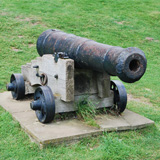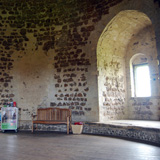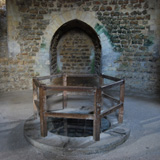History
Orford Castle is located in Suffolk, England, near the North Sea coast, northeast of Ipswich, and was built in the 12th century by King Henry II to protect England's coast against foreign invasion from France and to curtail any uprisings by the barons of East Anglia, especially Hugh Bigod, the Earl of Norfolk, who owned nearby Framlingham Castle.
During the reign of Henry's predecessor, King Stephen, a civil war between the King and Henry's mother, Empress Matilda, led to anarchy and a time when barons became used to independence and guarded against any royal interference by building illegal castles.

When Stephen died, Henry became King of England. His first task was to reestablish order and authority throughout his kingdom, including England, and lands he held in France as the Duke of Normandy and Aquitaine, Count of Anjou, and Lord of Brittany. Castles meant power, so Henry demanded the return of once-royal castles and the destruction of castles built illegally. At the same time, he strengthened the castles he had already owned at Carlisle, Newcastle, Scarborough, and especially Dover.
A significant problem for Henry was Hugh Bigod, Earl of Norfolk, who owned four castles in Suffolk and was one of the most powerful barons in East Anglia. So Henry confiscated his four castles in 1157 and built Orford Castle in Suffolk to help keep Hugh in check. In 1165, Henry returned two castles to Hugh, Framlingham Castle and Bungay Castle, in return for a heavy fine paid to the King. Henry built Orford Castle between Framlingham Castle and the coast to monitor any foreign mercenaries or supplies arriving for Framlingham from the sea. It also enabled Henry to resupply Orford Castle from the sea in times of trouble.
Orford Castle protected the harbor and was part of the group of lordships in Suffolk that Henry gave to his friend and Chancellor, Thomas Becket. Henry took the castle back in 1164, sometime after Becket became the Archbishop of Canterbury and started quarreling with the King and fled to France. The construction of Orford Castle was completed just in time. In 1173, a serious revolt broke out, led by Henry's son and heir, also named Henry, who Scotland, France, and Flanders also supported. Now 80 years old, Hugh Bigod also joined the revolt against King Henry and landed Flemish mercenaries in Suffolk. The King reinforced Orford Castle with supplies and men to defend against the revolt. The rebel army landed near Walton Castle but failed to take Orford, and Hugh Bigod decided not to attack Orford Castle. The Earl of Leicester was defeated near Bury St Edmunds, and King Henry defeated Louis of France on the borders of Normandy. In 1174, Hugh Bigod submitted to the King, surrendered his castles, and saw them all destroyed, including Framlingham Castle.
Henry spent more than half his time as King on the continent and possibly never saw his castle at Orford. His son Richard I, the Lionheart, spent even less time in England as he was always on crusade. However, his mother, Eleanor, did send a fleet of ships from Orford Castle in 1194 to deliver the ransom money to free Richard when he was taken prisoner.
King John succeeded his brother Richard I in 1199, and Orford was garrisoned when the barons rebelled in 1215 and invited Louis, Prince of France, to invade East Anglia. Louis captured several castles, including Cambridge, Colchester, Hedingham, and Orford Castle, after King John died in 1216. Orford Castle sustained minor damage, which was repaired.
In the 1260s, during the Barons' War against Henry III, Orford Castle was still a significant stronghold in East Anglia and changed hands several times. It was twice held by Roger Bigod, Earl of Norfolk, and in 1264, when the Second Barons' War broke out, Henry III gave Orford Castle to his eldest son, Prince Edward. Edward succeeded his father in 1272, becoming King Edward I, Edward Longshanks. Edward passed through East Anglia many times and spent a night at Orford Castle on April 11th, 1277, the only known time a reigning monarch has visited the castle.
In 1336, Edward III sold Orford Castle to the younger Robert of Ufford, who was created Earl of Suffolk the following year. The castle remained in private ownership from then onwards. Michael Stanhope bought the castle from the Willoughby family in the 1590s and probably began dismantling the rampart walls surrounding Orford Castle to reuse the stone to build nearby Sudbourne Hall. Years of decay and abandonment followed for the castle.
In 1804, a signal station was built next to the castle, and the equipment was moved to the top of the castle. The signaling equipment was updated in 1812, and Orford Castle was used as a radar station during World War II. In 1928, Sir Arthur Churchman gave the castle to the Orford Town Trust. The Ministry of Works, later English Heritage, was given guardianship of the castle in 1962 and opened the castle to the public.
Castle Highlights
Orford Castle has one of the most unique polygonal tower keeps in England. Still intact to its full height, it allows visitors to explore from the basement to the upper halls to see the 12th century design and rooms up close. An audio tour is available as you walk the castle's rooms at your own pace.
The basement has a well for fresh water. The upper floors house the chapel, kitchen, living chambers, and the Orford Museum, which is located on the keep's first floor. The museum visit is included with entry to the castle.
Apart from the keep and some earthwork ditches, nothing of the outer castle walls and towers surrounding the keep remains. It should take less than half a day to visit Orford Castle entirely. If you want to spend a whole day seeing castles, Framlingham Castle is only 12 miles from Orford.
There is a legend associated with Orford Castle.


